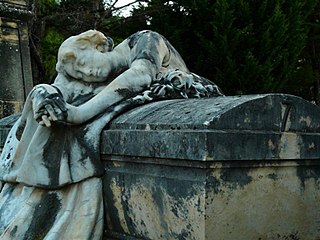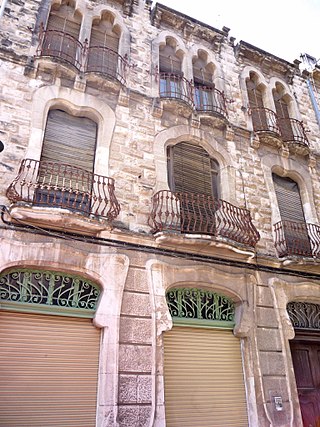
Art Nouveau is an international style of art, architecture, and applied art, especially the decorative arts. It was often inspired by natural forms such as the sinuous curves of plants and flowers. Other characteristics of Art Nouveau were a sense of dynamism and movement, often given by asymmetry or whiplash lines, and the use of modern materials, particularly iron, glass, ceramics and later concrete, to create unusual forms and larger open spaces. It was popular between 1890 and 1910 during the Belle Époque period, and was a reaction against the academicism, eclecticism and historicism of 19th century architecture and decorative art.

Valencia is the capital of the autonomous community of Valencia and the third-most populated municipality in Spain, with 792,492 inhabitants (2022). It is the capital of the province of the same name. The wider urban area comprising the neighbouring municipalities has a population of around 1.6 million, constituting one of the major urban areas on the European side of the Mediterranean Sea. It is located on the banks of the Turia, on the east coast of the Iberian Peninsula at the Gulf of Valencia, north of the Albufera lagoon.

Moros y Cristianos or Moros i Cristians literally in English Moors and Christians, is a set of festival activities which are celebrated in many towns and cities of Spain, mainly in the southern Valencian Community. According to popular tradition, the festivals commemorate the battles, combats and fights between Moors and Christians during the period known as Reconquista. There are also festivals of Moros y Cristianos in Spanish America.

Jorge Majfud is a Uruguayan American professor and writer.

Pedro de Orrente was a Spanish painter of the early Baroque period who became one of the first artists in that part of Spain to paint in a Naturalistic style.

Alcoy is an industrial and university city, region and municipality located in the Valencian Community, Spain. The Serpis river crosses the municipal boundary of Alcoy. The local authority reported a population of 61,135 residents in 2018.
Federico Martínez Roda is a professor of history at the Valencia Catholic University.

Enrique García Hernán is a Spanish historian of the culture of early modern Europe. His research examines the interaction of religious sentiment, political thought and international relations in the sixteenth, seventeenth and eighteenth centuries. It attempts to bridge the gap between the study of forms of cultural and intellectual expression and the realities of political, diplomatic and military organization. He is a Corresponding Fellow of the Royal Academy of History, member of the Board of Directors (Vocal) of the Spanish Commission for Military History, and Fellow (Académico) of the Ambrosiana Academy of Milan. His current academic affiliation is as a research professor in the Institute of History, within the Center for Humanities and Social Sciences at the Spanish National Research Council. The Spanish National Research Council is the largest public institution dedicated to research in Spain and the third largest in Europe.

The history of Valencia, one of the oldest cities in Spain, begins over 2100 years ago with its founding as a Roman colony under the name "Valentia Edetanorum" on the site of a former Iberian town, by the river Turia in the province of Edetania. The Roman consul Decimus Junius Brutus Callaicus transferred about 2,000 veteran soldiers who had fought under him to Valentia in 138 BC. Valentia lay in a strategic location near the sea on a river island that would later be crossed by the Via Augusta. Pompey razed Valentia to the ground in 75 BC; it was rebuilt about fifty years later with large infrastructure projects, and by the mid-1st century, was experiencing rapid urban growth with many colonists from Italy.
Timoteo Briet Montaud was a Spanish architect, one of the main architects of the Art Nouveau in Alcoy and the Valencian Art Nouveau.

Vicente Juan Pascual Pastor was a spanish architect, one of the main architects of the Art Nouveau in Alcoy and the Valencian Art Nouveau.

Art Nouveau in Alcoy, as one of the main focuses of the Valencian Art Nouveau, is the historiographic denomination given to an art and literature movement associated with the Art Nouveau in Alcoy (Alicante), Valencian Community, in Spain.

Valencian Art Nouveau is the historiographic denomination given to an art and literature movement associated with the Art Nouveau in the Valencian Community, in Spain.

The Casa del Pavo is a private building at 15 Sant Nicolau Street, in the city center of Alcoy (Alicante), Valencian Community, Spain. It is one of the main works of the Art Nouveau in Alcoy.

The Circulo Industrial de Alcoy(Alcoy's Industrial Circle) is a cultural institution from Alcoy (Alicante), Valencian Community, Spain, founded on January 1, 1868. It is placed at 19 Sant Nicolau street, in the city center of Alcoy.

The Casa Laporta(Laporta house) is a private building at 26 País Valencià avenue, in the city center of Alcoy (Alicante), Valencian Community, Spain. It is one of the main works of the Art Nouveau in Alcoy.

The Casa d'Escaló(Escaló house) is a public building at 2 Joan Cantó street, in the city center of Alcoy (Alicante), Valencian Community, Spain. It is one of the main works of the Art Nouveau in Alcoy.

The Cementerio de San Antonio Abad(transl. Saint Anthony Cemetery) or Cementeri d'Alcoi is a cemetery located in Alcoy (Alicante), Spain.

The Casa Vilaplana(Vilaplana house) is a private building at 8 Joan Cantó street in the city center of Alcoy (Alicante), Valencian Community, Spain.
Art Nouveau in Madrid is the historiographic term given to the artistic style Art Nouveau as it developed in and around Madrid, the capital of Spain, around 1900, permeating architecture, design, the decorative arts, graphic arts, and broader culture. There is also a “Modernismo madrileño” in the field of literature, likewise situated in the capital and considered to be the nucleus of the origins of the modern movement of Spanish literature.
















